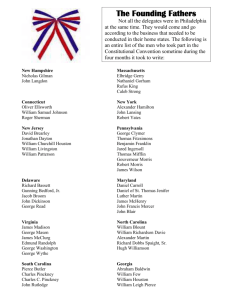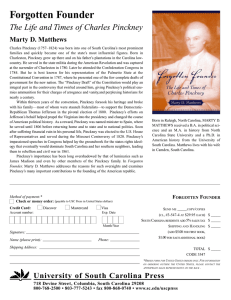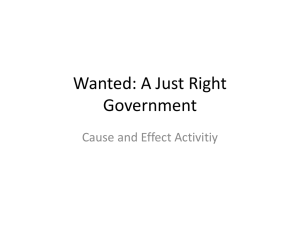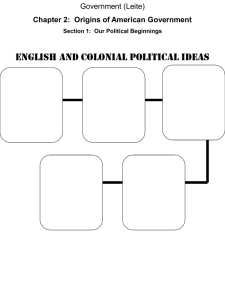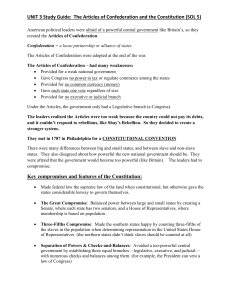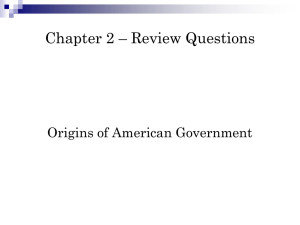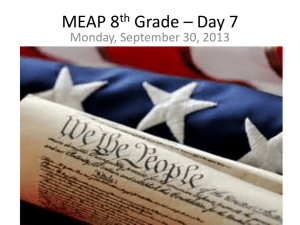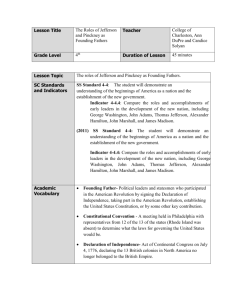Chapter 3—Answers
advertisement
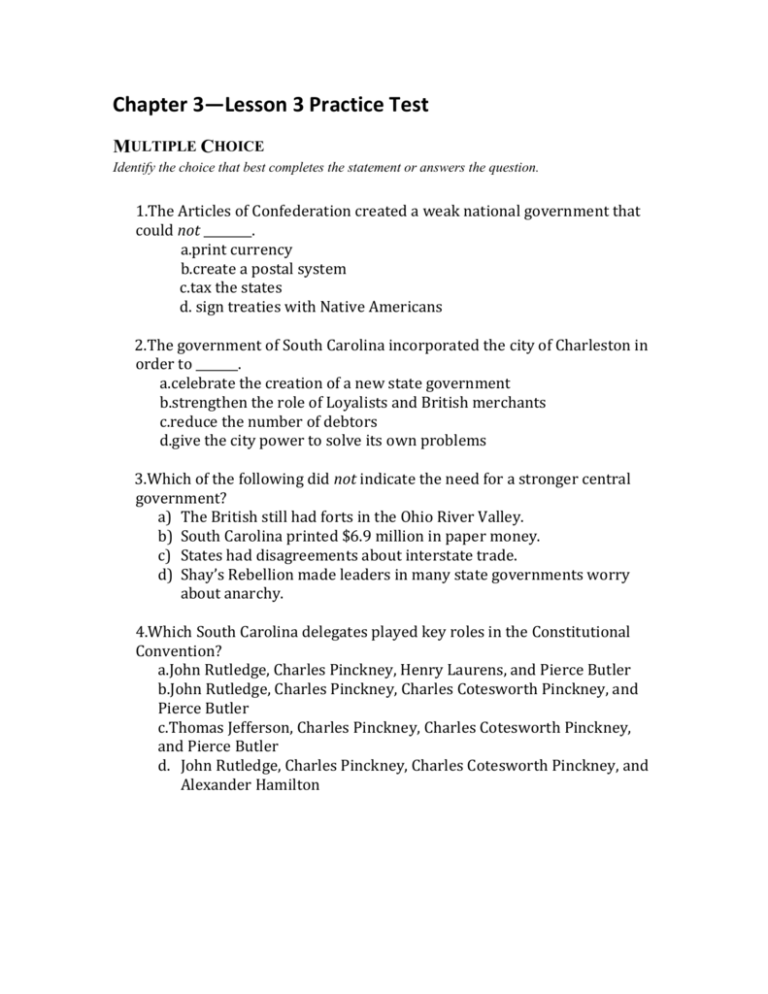
Chapter 3—Lesson 3 Practice Test MULTIPLE CHOICE Identify the choice that best completes the statement or answers the question. 1.The Articles of Confederation created a weak national government that could not ________. a.print currency b.create a postal system c.tax the states d. sign treaties with Native Americans 2.The government of South Carolina incorporated the city of Charleston in order to _______. a.celebrate the creation of a new state government b.strengthen the role of Loyalists and British merchants c.reduce the number of debtors d.give the city power to solve its own problems 3.Which of the following did not indicate the need for a stronger central government? a) The British still had forts in the Ohio River Valley. b) South Carolina printed $6.9 million in paper money. c) States had disagreements about interstate trade. d) Shay’s Rebellion made leaders in many state governments worry about anarchy. 4.Which South Carolina delegates played key roles in the Constitutional Convention? a.John Rutledge, Charles Pinckney, Henry Laurens, and Pierce Butler b.John Rutledge, Charles Pinckney, Charles Cotesworth Pinckney, and Pierce Butler c.Thomas Jefferson, Charles Pinckney, Charles Cotesworth Pinckney, and Pierce Butler d. John Rutledge, Charles Pinckney, Charles Cotesworth Pinckney, and Alexander Hamilton 5.What issue did South Carolina delegates emphasize during the Constitutional Convention? a.Making sure all of the states got equal representation in Congress b.Establishing diplomatic relations with Britain and France c.Maintaining the institution of slavery in the South d.Using the terms “slave” and “slavery” in the document where appropriate 6.One of the chief concerns of the Anti-federalists was _________. a.the need for a Bill of Rights in the Constitution b.keeping the right to tax at the state level, not the federal level c.establishing interstate roads and other transportation systems d.making sure Congress was unicameral, with representation based on population Matching. 7.Created a loose alliance of states A.Federalists 8.Refused to allow Americans to use the Mississippi R B.Separation of Powers 9.Govt. seizing farms of indebted farmers led to C. Checks and Balances 10.Constitutional Convention began this political tradition D.Spanish 11.Determined counting of slaves for representation E.30 years 12.Atlantic slave trade will continue how long F.Anti-Federalists 13. Stops a branch of gov’t from gaining too much power G.Articles of Confederation 14. Low Country leaders in favor of the Constitution H. 3/5 Compromise 15. Up Country leaders who did not favor the Constitution I.James Madison 16. Congress’s first act which led to ratification J. Bill of Rights 17. 1st Secretary of Treasury who was a Federalist K.Thomas Jefferson st 18. 1 Secretary of State who was a Republican L. Alexander Hamilton 19. ensured that British would keep forts Ohio R. Valley M. 20 years 20. Formally approve N. Ratify 21. Included both proportional and equal representation O. Shay’s Rebellion 22. First ten constitutional amendments P. Mexico Q.Bill of Rights R. Great Compromise S. Compromise Review the following: Definitions of Essential Terms Chapter 3 Lesson 3 Reading Guide pages 99-104 Notes covering the remainder of Lesson 3 5 Questions Answered in class from page115(most of you took pictures) Focus on Compromises Focus on Contrasting the Federalists and Anti-Federalists Establishing a New Government Quiz South Carolina’s leaders during this era Reason why capital was moved to Columbia Lesson 3 Key Ideas: Essential Information to Understand DEFINITIONS Define the terms and explain how they are related to each other. 23. duty _______________________________________________________________________________ boycott ____________________________________________________________________________ relationship _______________________________________________________________________ 24. smuggle ___________________________________________________________________________ writ ________________________________________________________________________________ relationship _______________________________________________________________________ 25. siege _______________________________________________________________________________ morale _____________________________________________________________________________ relationship _______________________________________________________________________ 26. confederation ____________________________________________________________________ constitution _______________________________________________________________________ relationship _______________________________________________________________________ Chapter 3—Answers 1. B 2. A 3. C 4. B 5. D 6. C 7. A 8. C 9. B 10. A 11. C 12. C 13. D 14. A 15. B 16. A 17. C 18. D 19. B 20. B 21. C 22. A 23. duty: a government tax on specific products, often imported boycott: a form of protest or punishment where one party refuses to buy goods from another As a result of the duties placed on American colonists, some patriots responded by boycotting British goods. 24. smuggle: to import or export goods secretly and in violation of law writ: an official order issued by the government When colonists defied the British by smuggling goods, the British searched their houses using writs of assistance. 25. siege: a military blockade combined with the relentless attack on a city or fort morale: the enthusiasm and confidence of a group, especially a fighting force After the British laid siege to Charles Town and captured the city, morale among South Carolina Patriots was low. 26. confederation: a partnership among countries or states in which authority over all is loosely shared constitution: a document containing the fundamental political principles on which a state or nation is governed When the new nation’s Articles of Confederation turned out to be ineffective, delegates from each state held a convention to write a better plan for government, the Constitution.

